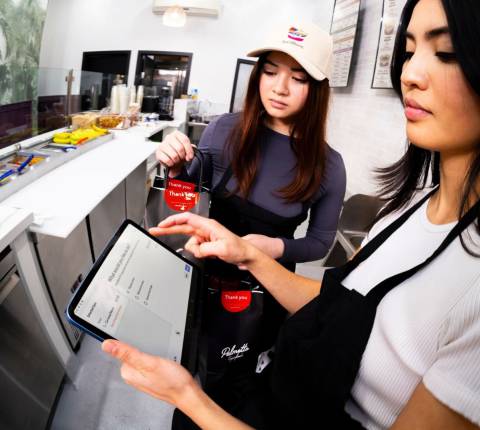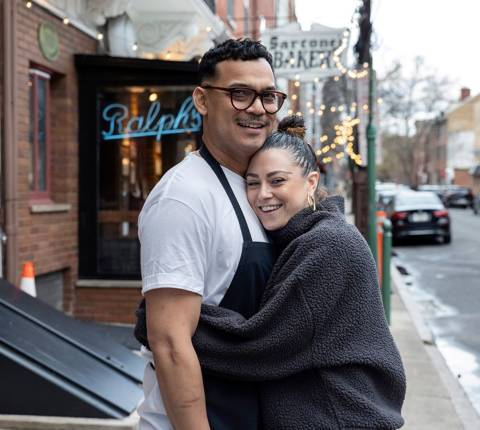All over the world, people are growing more and more committed to stopping climate change and living in a more eco-friendly way. As a result, governments have started enacting policies banning single-use plastics — including many of the plastic containers, cutlery, and bags regularly used for food delivery and takeout.
Many restaurants have already been using eco-friendly packaging for years. Not only is it better for the planet, but it’s also a great way to appeal to Gen Z and Millennial customers who prefer to support sustainable businesses.
What to consider when choosing eco-friendly takeaway food containers
Insulation
For reasons of food safety and deliciousness, restaurants should look into insulated food delivery containers — especially if your delivery range allows for food to sit in transit for over an hour. If your hot food is arriving completely cold, or your cold dishes arrive at a disconcerting room temperature, your customers won’t be excited to dig in — and might not order again. Keep food hot for delivery with high-quality insulated containers.
Spill-testing
Thoroughly spill-test eco-friendly delivery and takeout containers before you place that order of 2,000 boxes. Customers who open a takeout bag only to find that the dressing, soup, or sauce has spilled everywhere will be disappointed and put off — so buy a small amount of containers to test, fill them with food, and toss them around like they’d would be in a delivery car. While most delivery drivers will be careful not to shake up their deliveries too much (their five-star reviews depend on it), accidents do happen. If your test boxes spill easily, find another brand to test.
Price
A major part of why the restaurant industry is so accustomed to using plastic containers is that they’re often the cheapest option. And in an industry with such thin profit margins, there’s often little wiggle room to opt for things like nicer takeout containers. However, it’s better to be proactive ahead of changing government regulations instead of having to switch over all at once as soon as a law passes.
Try out a few strategies to reduce other restaurant costs so you have room in your budget to start transitioning to eco-friendly packaging.
Sustainability
Not all eco-friendly food containers are created equal. Here’s a breakdown on a few of the popular labels you’ll see on sustainable containers.
Compostable: Compostable materials break down quickly when disposed of properly, either in a commercial or home compost, naturally becoming nutrient-rich materials that can be used in soil to encourage plant growth. Containers made with sugarcane/bagasse, bamboo, and some bioplastics are typically compostable.
Biodegradable: Biodegradable takeout containers are made of bioplastics and other materials made from plants, meaning they will naturally disintegrate over time. However, the rates of decomposition vary based on the material, and some governments are beginning to set regulations for using the label based on how much and how quickly the material breaks down — so remember to research local policies to determine the best biodegradable packaging options for your area.
Recycled: Recycled packaging is made of previously used plastic or other materials, ensuring that at least some of the plastic used in the industry doesn’t go to waste. Some recycled containers are recyclable themselves, but not all — check with your local recyclable requirements. Kraft paper products are made with virgin fibers but are renewable, recyclable, and easily customizable.
Reusable: Products that are able to be used again after their initial use, like sturdy plastic containers, reusable coffee cups, or reusable salad bowls are great ways to cut back on your environmental footprint. If you frequently have people ordering coffee to-go, consider offering a discount if they bring their own thermos.
How to keep food hot (or cold) for delivery
As mentioned above, a big part of providing amazing off-premise customer service is testing your takeout containers to ensure all food holds up well in transit. Prepare several of your dishes and distribute them into takeout containers — and then jostle them around and wait 30+ minutes before eating them. If they don’t hold up, cut menu items or try upgrading your packaging.
Plus, it’s good practice to pack sauces on the side and separate foods of different temperatures: a steaming hot container of penne in vodka sauce shouldn’t be sitting in the bag on top of a fresh, cool caesar salad.
What kinds of takeout containers do restaurants use?
Restaurant operators have a wide variety of food delivery containers to choose from. Here's an overview of some of the most common takeout packaging types, to help you choose the right mix for your business.
Soup containers
Made out of plastic, styrofoam, or plastic-coated cardboard with a plastic lid, these containers transport soup from restaurant to customer. Different materials insulate better than others, so do a temperature test in the restaurant comparing different types. Smaller versions, often made of plastic, are great multi-use takeout containers for curries, stews, and smaller portions of soup.

Seal-top boxes
Perhaps the most common kind of takeout container, seal-top boxes are round or rectangular, and almost always made of plastic. They’re sturdy enough to be washed and reused for at-home food storage, and as their name implies, they seal quite well — but they’re not water-tight.

Salad bowls
Made of compostable material, plastic, or plastic-coated paper with a plastic lid, these bowls transport salads very effectively. It’s common to send a small container of dressing inside the bowl — and it’s important to do a shake test. Make sure a freshly dressed salad can be shaken vigorously with the closed salad bowl container not popping open and making a huge mess.

Divided takeout containers
Usually made of plastic or styrofoam, these containers are great for transporting combo meals, mains and sides, and bento boxes — but they do cause quality issues if cold foods (like salads) are packed in the same container as warm foods (like chicken tikka). They typically come with a container and a separate lid.
Clamshell container
Clamshell containers are defined by the hinged closure: the base and the lid are connected on one side, and open like a clamshell. They’re usually made of styrofoam or compostable materials, and are great for burgers and sandwiches.
Folding boxes
Made of lined, coated paper or cardboard, which is often recycled, these containers are great for takeout and delivery food that doesn’t need to be perfectly sealed, like rice dishes or sandwiches. Chinese takeout containers are similar, but are often shaped in a square instead of a rectangle.

Catering containers
Typically made of aluminum, catering containers are large trays with coated cardboard or plastic lids, and they can transport large amounts of food that can go straight into the oven to be heated up. There are also round, plastic catering containers, which are often used for large orders of sushi, finger sandwiches, or fruit platters.
Pizza boxes
Perhaps the most specialized of the takeout containers, pizza boxes are made of cardboard and are designed to bring pizzas, calzones, or hot sandwiches fresh from the oven to a customer’s front door.
Vented containers
Vented containers are important for restaurants that specialize in fried food, like fried chicken, calamari, or pakoras. They let hot air out of the container so the fried food stays crispy, not steamed and soggy. They’re usually paper-based or compostable.
Takeout sauce containers
Generally made of plastic, sauce containers are used to send dressing on the side, dipping sauces for wings, mozzarella sticks, or fries, or any other additional topping that customers can add when they receive their food. Sending sauce or garnishes on the side help keep food tasting its best, despite the delay from kitchen to couch.
Custom takeout boxes
The most eco-friendly way to customize your takeout containers (or bags) is with a custom stamp and ink — no need to buy plastic stickers or pricey branded containers.
Restaurant sustainability beyond food delivery containers
Following are a few additional tips to help your restaurant be more eco-friendly when it comes to your delivery and pickup packaging.
1. Remove utensils, straws, and napkins from to-go food packaging
When people order delivery, they probably already have forks and knives at home. Spare the waste — and the expense — by allowing them to opt in or out of cutlery when they order.
2. Reduce excess packaging
By investing in high-quality to-go food containers, you're less likely to need added layers of packaging, like plastic wrap, cardboard, or double bags.
3. Avoid unnecessary marketing materials
If your customers ordered online via DoorDash or your website, it's a safe bet that they already know where to find your menu online. Save paper menus or other marketing materials for passersby who drop in wanting to take one home with them, and skip it in delivery orders.
Besides, you can still add a personal touch to every order by writing a quick "Thank you" or a smiley face on the takeout containers or paper bags themselves.
Prioritizing quality and sustainability in restaurant takeaway food packaging
By understanding your options for sustainable food delivery containers, you can make an informed decision about which takeout packaging is right for your business. Learn more about increasing online orders and ensuring customer satisfaction with our Guide to Optimizing for Delivery & Pickup.





